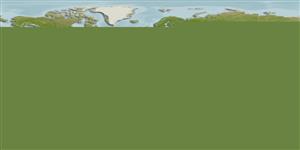>
Gobiiformes (Gobies) >
Gobiidae (Gobies) > Gobiinae
Etymology: Lubricogobius: Latin, lubricus = slipperiness, smoothness + Latin, gobius = gudgeon (Ref. 45335).
More on author: Tanaka.
Environment: milieu / climate zone / depth range / distribution range
Ecología
marino demersal; rango de profundidad 5 - 100 m (Ref. 45340). Subtropical
Distribución
Países | Áreas FAO | Ecosistemas | Ocurrencias, apariciones | Point map | Introducciones | Faunafri
Western Pacific: southern Japan to Indonesia.
Tamaño / Peso / Age
Maturity: Lm ? range ? - ? cm
Max length : 4.0 cm SL macho / no sexado; (Ref. 48637)
Espinas dorsales (total): 7; Radios blandos dorsales (total): 8-10; Espinas anales 1; Radios blandos anales: 5 - 7. Pelvic fins with a well-developed frenum; anterior nostrils usually present (rarely absent on one side); dorsal and ventral edges of caudal peduncle strongly keeled; bright yellow in color (Ref. 45340).
Inhabits shallow inshore to moderate depth on muddy substrates, usually with small outcrops of rubble or debris (Ref. 48637). Collected from muddy sand bottom (Ref. 45340).
Life cycle and mating behavior
Madurez | Reproducción | Puesta | Huevos | Fecundidad | Larva
Randall, J.E. and H. Senou, 2001. Review of the Indo-Pacific gobiid fish genus Lubricogobius, with description of a new species and a new genus for L. pumilus. Ichthyol. Res. 48(1):3-12. (Ref. 45340)
IUCN Red List Status (Ref. 130435)
Threat to humans
Harmless
Human uses
Más información
PaísesÁreas FAOEcosistemasOcurrencias, aparicionesIntroduccionesStocksEcologíaDietacomponentes alimenticiosconsumo de alimentoRación
Nombres comunesSinónimosMetabolismoDespredadoresEcotoxicologíaReproducciónMadurezPuestaAgregación para la puestaFecundidadHuevosEgg development
ReferenciasAcuiculturaPerfil de acuiculturaRazasGenéticaElectrophoresesheritabilidadEnfermedadesProcesamientoNutrientsMass conversion
ColaboradoresImágenesStamps, Coins Misc.SonidosCiguateraVelocidadTipo de nataciónSuperficie branquialOtolitosCerebrosVisión
Herramientas
Special reports
Download XML
Fuentes de Internet
Estimates based on models
Preferred temperature (Ref.
123201): 20.7 - 29, mean 27.5 °C (based on 446 cells).
Phylogenetic diversity index (Ref.
82804): PD
50 = 0.5156 [Uniqueness, from 0.5 = low to 2.0 = high].
Bayesian length-weight: a=0.01023 (0.00477 - 0.02194), b=3.02 (2.84 - 3.20), in cm total length, based on LWR estimates for this (Sub)family-body shape (Ref.
93245).
Nivel trófico (Ref.
69278): 3.2 ±0.3 se; based on size and trophs of closest relatives
Resiliencia (Ref.
120179): Alto, población duplicada en un tiempo mínimo inferior a 15 meses (Preliminary K or Fecundity.).
Fishing Vulnerability (Ref.
59153): Low vulnerability (10 of 100).
